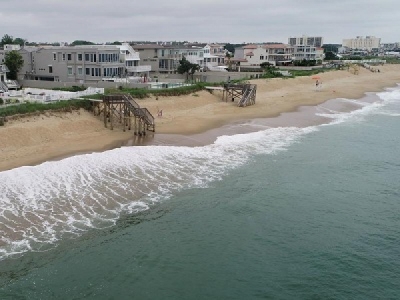
Posted on June 5, 2018
By Stacy Parker, The Virginian-Pilot
Croatan residents have been watching the beach near their homes slowly wash away for years.
They’ve asked the city for a more permanent solution to the problem as storms kick up waves that claw away the dunes. Each year, Public Works reinforces them with sand, but the fix is always short-lived.
City leaders have been worried that conditions could get worse and eventually pose more of a threat to beachfront homes.
“There’s a lot of expensive real estate on the other side of those dunes that needs to be protected,” Deputy City Manager Tom Leahy said.
A solution may be at hand.
The city manager has asked the federal government to study whether changes to the Rudee Inlet jetty system would benefit Croatan’s shoreline.
“In order to put a wider beach out there, we have to modify the inlet,” said Phillip Roehrs, water resources engineer for the city.
Public Works officials analyzed a 2016 assessment of Croatan’s shoreline and are confident that moving the Rudee Inlet weir and South Jetty farther out in the water would reshape the beach.
But it could be several years before any work would begin.
Susan Conner, chief of planning and policy for the Army Corps of Engineers’ Norfolk District, said a study on extending the system would take about three years to complete and wouldn’t likely begin until 2020. The study could cost about $3 million, which would be split between the corps and the city, Conner said.
The challenge with Croatan is to balance a desire for a wider beach and making sure the inlet, a federal channel, remains navigable.
Rudee Inlet provides direct ocean access for commercial fishing and recreational boating. It opened in 1927 when the Virginia Department of Highways installed a small concrete flume across a drainage ditch to support the existing road system.
Today, two jetties protect vessels and dredging equipment in the harbor.
The south jetty, called a “breakwater” because it is not connected to land, helps prevent sand from clogging up the inlet. It works in conjunction with a weir, which also helps break the waves and send sand into an 18-foot-deep trap.
Currents during storms have generally moved sediment from the south to the north.
The city and the corps dredge the inlet and the trap. Most of the sand is placed north, on the resort area beach, which was widened years ago.
On a recent morning in Croatan, a lifeguard on an ATV navigated between the edge of the water and a set of stairs.
Allen Pyle, a real estate broker who lived in the neighborhood for 25 years, raised red flags with the city manager and council members in a letter earlier this month about the shrinking beach.
“Property values and rental incomes are being negatively impacted,” Pyle wrote. “Businesses are challenged as it is becoming difficult to advertise ‘beach vacations’ when there is no room on our Croatan beach.”
Home sales have dropped by 50 percent since 2013 and Oceanfront houses are staying on the market longer, according to Pyle.
“I’m concerned about people coming in for a vacation rental,” he said. “And if it’s a high tide, they won’t even be able to put their beach chairs and umbrellas on the beach.”
Source: The Virginian-Pilot





